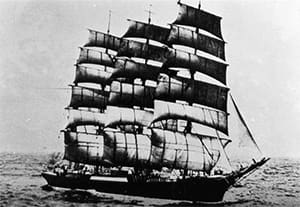From the time it was discovered in 1616 by the Dutchman Willem Schouten, and named for the town of his birth, Hoorn, Cape Horn has held the image of doom and redemption, heartache and tragedy in the minds of mariners. More than 1,000 ships met their end there, with more than 15,000 sailors lost.
Cape Horn, located at 55° 58’ S by 67° 17’ W, is the southern headland of Horn Island, Chile. The first Europeans to see it were father and son Isaac and Jacob Le Maire, successful Dutch merchants. The shorter and dangerous approach to the Cape, the Strait of Le Maire, is named in their honor.
Rounding Cape Horn from east to west was a serious business, yet captains who knew their stuff and had good ships with good owners routinely made passages from Europe to the West Coast of Chile in less than three months. No country did this better than the Germans, and no company was more successful than that of F. Laeisz and Sons. The company’s “P-Line” ships — barquentines, four- and even five-masted full-rigged ships — hold all the records for the fastest passages with the least loss of life. It was Laeisz’s ship, Pamir that was the last commercial sailing ship to round the Horn in 1949.
Many ships fought for months trying to make it to the West, finally either succeeding, wrecking or turning around. Captain Bligh aboard Bounty spent 31 days making 85 miles to the West before he turned to go to Tahiti by sailing around the Cape of Good Hope. In 1740, George Anson spent three months getting around Cape Horn.
The distance run was at least 1,200 miles. Not only did the captains have to fight the strong westerlies, but also a powerful southern ocean current setting to the East. Ocean Passages of the World says among other things, “When the wind is strong and opposed to the tidal streams, the overfalls are overwhelming and very dangerous, even to a large and well-found vessel.”
The record holder for the fastest rounding of the Horn was made by the cargo-carrying school ship Priwall in 1937. It took five days and 14 hours. Priwall was a 20-year-old, four-masted barque of 3,100 tons, built at the Blohm and Voss Shipyard in Hamburg for the Laeisz Line. In the 1930s it had a crew of 72, of which 55 were cadets.
Priwall’s master was Captain Adolph Hauth, 39, the youngest of the Cape Horn masters at the time. He already had 25 years experience. He took command of Priwall in 1937, outward bound to Valparaiso with general cargo and coming back with guano. This was his third rounding of Cape Horn on a passage that took 72 days from Hamburg to Talcahuano, Peru. The rounding was made in early November and the ship took the dangerous shortcut through the Le Maire Strait on a strong northwesterly.
Let’s join our intrepid captain on Oct. 31. We will use the 2016 NA. Our height of eye is 20 feet. We are taking a lower limb sight of the sun. It is true that at the time of the passage, stellar observations were taken sometimes to ascertain longitude, but the tried-and-true method was to DR and to find LAN latitude. DR at the time of the sight is 49° 54’ S, 65° 53’ W. Priwall is beginning to make the turn west, rounding the Horn. Noon sight time is at 1607 GMT and the Hs of the lower limb of the sun is 54° 17’.
A. What is the latitude?
A: Latitude is S 49° 55.8’

